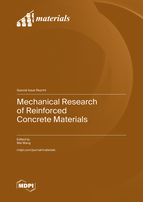Mechanical Research of Reinforced Concrete Materials
A special issue of Materials (ISSN 1996-1944). This special issue belongs to the section "Construction and Building Materials".
Deadline for manuscript submissions: closed (20 August 2023) | Viewed by 15845
Special Issue Editor
Interests: reinforced concrete structures; dynamic mechanics of materials; blast effect; blast damage assessment; dynamics of structures
Special Issues, Collections and Topics in MDPI journals
Special Issue Information
Dear Colleagues,
Reinforced concrete (RC) is a principal construction material used for civilian and military buildings due to its superior material characteristics over steel and timber (e.g., higher durability, corrosion resistance, and fire resistance). These inherent properties of reinforced concrete make it suitable for the construction of most civil engineering structures, for example, bridges, dams, nuclear containment structures, protective/defense structures, and residential/embassy buildings. These important structures are always high-priority targets of terrorists. Concrete is a frequently used material subjected to intense dynamic loadings in civil and defense engineering, such as blast and impact loadings, which can induce high pressure, high strain rate, and large strain in concrete structures. The response of the structure becomes very complex due to the effects of high inertia, large strain rate, high temperature, and the travel of shock waves through the reinforced concrete. Although the mechanical behaviors of reinforced concrete have been a research theme tackled by many researchers through experimental and theoretical approaches for 200 years, an accurate and comprehensive description of the actual mechanical behavior exhibited by reinforced concrete at service and ultimate conditions remains a challenge in the field of structural engineering.
This Special Issue is aimed at soliciting contributions focused on characterizing the mechanical performance of reinforced concrete materials. The scope of papers includes theoretical, experimental, and numerical studies that assess the general deformation response, damage evolution, and failure morphology of ordinary and high-performance reinforced concrete materials under various loading conditions (e.g., quasi-static, dynamic, fatigue, and impact). Investigations of reinforced concrete structures’ impact/blast resistance and damage mechanism evolution, failure modes transition and energy absorption performance are also welcome.
It is my pleasure to invite you to submit a manuscript to this Special Issue. Full papers, communications, and reviews are all welcome.
Dr. Wei Wang
Guest Editor
Manuscript Submission Information
Manuscripts should be submitted online at www.mdpi.com by registering and logging in to this website. Once you are registered, click here to go to the submission form. Manuscripts can be submitted until the deadline. All submissions that pass pre-check are peer-reviewed. Accepted papers will be published continuously in the journal (as soon as accepted) and will be listed together on the special issue website. Research articles, review articles as well as short communications are invited. For planned papers, a title and short abstract (about 100 words) can be sent to the Editorial Office for announcement on this website.
Submitted manuscripts should not have been published previously, nor be under consideration for publication elsewhere (except conference proceedings papers). All manuscripts are thoroughly refereed through a single-blind peer-review process. A guide for authors and other relevant information for submission of manuscripts is available on the Instructions for Authors page. Materials is an international peer-reviewed open access semimonthly journal published by MDPI.
Please visit the Instructions for Authors page before submitting a manuscript. The Article Processing Charge (APC) for publication in this open access journal is 2600 CHF (Swiss Francs). Submitted papers should be well formatted and use good English. Authors may use MDPI's English editing service prior to publication or during author revisions.
Keywords
- structural materials
- mechanical behaviors
- reinforced concrete structures
- ordinary and high-performance reinforced concrete
- impact/blast resistance
- damage mechanism evolution
- failure modes







